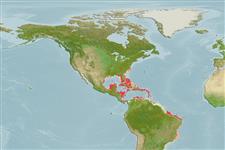Environment: milieu / climate zone / depth range / distribution range
Ekologi
laut; payau berasosiasi dengan karang. Subtropical
Western Atlantic: Bermuda, Florida Keys (USA), and Bahamas to northern South America. Scarce in western Gulf of Mexico (Ref. 26938).
Size / Weight / umur
Maturity: Lm ? range ? - ? cm
Max length : 15.0 cm TL jantan/; (Ref. 7251); 50.0 cm TL (female)
A very, slender, elongate, cylindrical eel with a projecting lower jaw. Lateral line complete ending at base of tail. (Ref. 26938).
Young and females burrow in sandy tide pools and reef tracts. Males inhabit deeper water, possibly pelagic. Adults emerge at night and sometimes come to lights at the surface (Ref. 26938). Feed on burrowing invertebrates that live in the sand (Ref. 26938).
Life cycle and mating behavior
Maturities | Reproduksi, perkembang biakan | Spawnings | Egg(s) | Fecundities | Larva
Robins, C.R. and G.C. Ray, 1986. A field guide to Atlantic coast fishes of North America. Houghton Mifflin Company, Boston, U.S.A. 354 p. (Ref. 7251)
Status IUCN Red List (Ref. 130435)
ancaman kepada manusia
Harmless
penggunaan manusia
Alat, peralatan
laporan khas
muat turun XML
Sumber internet
Estimates based on models
Preferred temperature (Ref.
123201): 23.8 - 28.2, mean 27.3 °C (based on 786 cells).
Phylogenetic diversity index (Ref.
82804): PD
50 = 0.5003 [Uniqueness, from 0.5 = low to 2.0 = high].
Bayesian length-weight: a=0.00102 (0.00046 - 0.00225), b=3.06 (2.88 - 3.24), in cm total length, based on all LWR estimates for this body shape (Ref.
93245).
Trophic level (Ref.
69278): 3.5 ±0.37 se; based on food items.
Fishing Vulnerability (Ref.
59153): Moderate vulnerability (40 of 100).
Nutrients (Ref.
124155): Calcium = 50 [20, 135] mg/100g; Iron = 0.584 [0.290, 1.102] mg/100g; Protein = 19.1 [16.8, 21.6] %; Omega3 = 0.203 [0.081, 0.560] g/100g; Selenium = 10.4 [4.1, 25.2] μg/100g; VitaminA = 114 [26, 489] μg/100g; Zinc = 1.4 [0.8, 2.2] mg/100g (wet weight);
